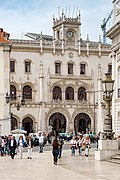José Luís Monteiro
José Luis Monteiro | |
|---|---|
 | |
| Born | October 25, 1848 Lisbon, Portugal |
| Died | January 27, 1942 Campo de Ourique, Portugal |
| Occupation | Architect |
José Luis Monteiro (1848–1942) was a Portuguese architect.[1] His work is considered among the most influential within late 19th century architecture.[2][3]
Life[]
José Luis Monteiro was born in Lisbon, Portugal on October 25, 1848.[4] At age 12, Monteiro enrolled in the Royal Academy of Fine Arts in Lisbon. In 1873 he moved to Paris to attend the École nationale supérieure des Beaux-Arts in Paris, completing his degree under the mentorship of Jean Louis-Pascal in 1879.[5]
In 1880, Monteiro returned to Portugal where he assumed a role as chief architect for the Lisbon City Council, in addition to a teaching position at the city's Royal Academy of Fine Arts, where he originally trained.[5] In 1901 he was awarded the Legion of Honor.[4]
Monteiro died on January 27, 1942 in Campo de Ourique, Portugal.
Work[]
Monteiro utilized a number of different architectural styles including Neoclassicism and French Second Empire. He is most well known for his revolutionary use of metal in the interior Rossio Railway Station; the building contained one of the first iron vaults in the nation.
Notable projects[]
- Hôtel de Ville (reconstruction), Paris, 1874[1]
- Rossio Railway Station, Lisbon, 1886[6]
- , Lisbon, 1881
- , Lisbon, 1890[4]
- Igreja dos Anjos, Lisbon, 1908[1]

Hôtel de Ville, Paris, 1874

Estação Rossio, Lisbon, 1886

, Lisbon, 1890

Igreja dos Anjos, Lisbon, 1908
References[]
- ^ Jump up to: a b c "José Luis Monteiro - Oxford Reference". www.oxfordreference.com. Retrieved 2019-01-27.
- ^ Burman, Peter (1998). Architecture 1900. Donhead. ISBN 9781873394328.
- ^ Cini.", Fondazione "Giorgio (1966). Encyclopedia of World Art: Pakistan to Rembrandt. McGraw-Hill.
- ^ Jump up to: a b c "Arquivo Municipal de Lisboa - José Luís Monteiro". arquivomunicipal.cm-lisboa.pt. Retrieved 2019-01-27.
- ^ Jump up to: a b Faria, Alberto. Três desenhos da aula de Arquitectura do "Mestre Monteiro" (PDF).
- ^ DK (2014-04-01). DK Eyewitness Travel Guide: Portugal. Penguin. ISBN 9781465422118.
- 1848 births
- 1942 deaths
- 19th-century architects
- 20th-century Portuguese architects




